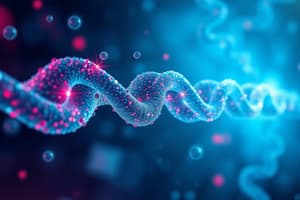Podcast
Questions and Answers
What is the main advantage of RFLP markers compared to other DNA fingerprinting techniques?
What is the main advantage of RFLP markers compared to other DNA fingerprinting techniques?
- RFLP markers do not require any prior sequence information
- RFLP markers are codominant, allowing both alleles to be detected
- RFLP markers are easier to score due to large size differences (correct)
- RFLP markers have a relatively high level of polymorphism
What is the main disadvantage of the RFLP technique compared to other DNA fingerprinting methods?
What is the main disadvantage of the RFLP technique compared to other DNA fingerprinting methods?
- RFLP has a relatively low level of polymorphism (correct)
- RFLP markers are dominant, not codominant
- RFLP is less sensitive in detecting genetic variation
- RFLP requires sequence information or probes, making it difficult and time-consuming
What is the key advantage of RAPD markers compared to other DNA fingerprinting techniques?
What is the key advantage of RAPD markers compared to other DNA fingerprinting techniques?
- RAPD is less time-consuming and labor-intensive than other methods
- RAPD markers are codominant, allowing both alleles to be detected
- RAPD does not require any specific knowledge of the DNA sequence of the target organism (correct)
- RAPD can produce a large number of polymorphic bands with a single primer pair
How does AFLP overcome the weaknesses of RFLP and RAPD methods?
How does AFLP overcome the weaknesses of RFLP and RAPD methods?
What is the potential power of the RAPD technique for detecting genetic polymorphism?
What is the potential power of the RAPD technique for detecting genetic polymorphism?
What is the main difference between RFLP and RAPD techniques in terms of DNA sequence information required?
What is the main difference between RFLP and RAPD techniques in terms of DNA sequence information required?
What is a disadvantage of using mtDNA data in genetic investigations?
What is a disadvantage of using mtDNA data in genetic investigations?
Why does sequence divergence accumulate more rapidly in mitochondrial DNA than in nuclear DNA?
Why does sequence divergence accumulate more rapidly in mitochondrial DNA than in nuclear DNA?
What is the role of restriction endonucleases in RFLP analysis?
What is the role of restriction endonucleases in RFLP analysis?
Why are PCR-based techniques preferred over Southern blot analysis in recent analyses?
Why are PCR-based techniques preferred over Southern blot analysis in recent analyses?
How are fragments analyzed in RFLP analysis if the flanking sequences are known for a locus?
How are fragments analyzed in RFLP analysis if the flanking sequences are known for a locus?
What does a relatively large deletion or insertion cause in RFLP analysis?
What does a relatively large deletion or insertion cause in RFLP analysis?
What is the unique feature of the AFLP technique?
What is the unique feature of the AFLP technique?
Which of the following statements about AFLP is correct?
Which of the following statements about AFLP is correct?
Which of the following is NOT one of the main steps in the AFLP technique?
Which of the following is NOT one of the main steps in the AFLP technique?
What is the purpose of the preselective PCR amplification step in AFLP?
What is the purpose of the preselective PCR amplification step in AFLP?
What is the main difference between AFLP and RAPD?
What is the main difference between AFLP and RAPD?
Which technique involves the analysis of base substitutions at PCR primer binding sites?
Which technique involves the analysis of base substitutions at PCR primer binding sites?
Study Notes
PCR Products
- PCR products can be digested with restriction enzymes and visualized by simple staining with ethidium bromide due to the increased amount of DNA produced.
RFLP
- RFLP has dominant markers, making scoring relatively easy due to the large size difference.
- A disadvantage of RFLP is the relatively low level of polymorphism.
- RFLP requires sequence information or probes, making it difficult and time-consuming.
- Restriction endonucleases recognize specific nucleotide sequences and cut DNA, resulting in fragments whose number and size vary among individuals, populations, and species.
- Digestion of DNA with restriction enzymes results in fragments that can be separated using Southern blot analysis or PCR.
RAPD
- RAPD uses PCR to randomly amplify anonymous segments of nuclear DNA with an identical pair of primers 8-10 bp in length.
- The potential power of RAPD is relatively high for detection of polymorphism, typically producing 5-20 bands using a given primer pair.
- RAPD doesn't require any specific knowledge of the DNA sequence of the target organism.
AFLP
- AFLP is a PCR-based, multi-locus fingerprinting technique that combines the strengths of RFLP and RAPD.
- AFLP includes five main steps: restriction of genomic DNA, ligation of adaptors to restricted fragments, preselective PCR amplification, selective PCR amplification, and electrophoretic separation of amplified DNA fragments.
- AFLP allows for the analysis of many loci simultaneously, similar to RFLP, but for multiple loci at once.
Mitochondrial DNA Markers
- Sequence divergence accumulates more rapidly in mitochondrial DNA due to a faster mutation rate.
- Mitochondrial DNA has a non-Mendelian mode of inheritance, making it a single locus in genetic investigations.
- A disadvantage of mtDNA is that it may not reflect the data of the nuclear genome.
Studying That Suits You
Use AI to generate personalized quizzes and flashcards to suit your learning preferences.
Description
Learn about the advantages and disadvantages of using restriction enzymes to digest PCR products and the benefits of using RFLP analysis in genetic studies. Understand the ease of scoring dominant markers and the drawbacks of low polymorphism levels.




